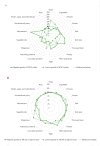Monounsaturated Fatty Acids in Cardiovascular Disease: Intake, Individual Types, and Content in Adipose Tissue as a Biomarker of Endogenous Exposure
- PMID: 40806094
- PMCID: PMC12348059
- DOI: 10.3390/nu17152509
Monounsaturated Fatty Acids in Cardiovascular Disease: Intake, Individual Types, and Content in Adipose Tissue as a Biomarker of Endogenous Exposure
Abstract
Unhealthy dietary patterns are a major modifiable risk factor for atherosclerotic cardiovascular disease (ASCVD). International guidelines recommend reducing saturated fatty acid intake while increasing polyunsaturated and monounsaturated fatty acids (MUFAs) to mitigate cardiovascular risk. However, evidence regarding MUFAs and risk of ASCVD remains conflicting, with recent studies raising concern about a potential higher risk associated with MUFA intake. The aim of this narrative review is to provide an overview of current knowledge and gaps in the literature regarding MUFAs and the risk of ASCVD with a focus on intake, individual types, and content in adipose tissue as a biomarker of endogenous exposure. Main findings reveal that most studies have inappropriately combined all MUFAs together, despite individual MUFA types having different biological effects and showing varying correlations between dietary intake and adipose tissue content. Adipose tissue composition may serve as a biomarker of long-term MUFA exposure, reflecting cumulative intake over one to two years while minimizing biases inherent in dietary assessments. However, tissue levels reflect both dietary intake and endogenous synthesis, complicating interpretation. Importantly, the source of MUFAs appears critical, with plant-derived MUFAs potentially offering advantages over animal-derived sources. In conclusion, we suggest that future research should focus on individual MUFA types rather than treating them as a homogeneous group, investigate their specific dietary sources and associations with ASCVD risk, and use adipose tissue biomarkers to improve exposure assessment and clarify causal relationships while considering overall dietary patterns.
Keywords: adipose tissue; atherosclerotic cardiovascular disease; diet; dietary patterns; endogenous exposure of MUFA; monounsaturated fatty acids.
Conflict of interest statement
The authors declare no conflicts of interest.
Figures


Similar articles
-
Prescription of Controlled Substances: Benefits and Risks.2025 Jul 6. In: StatPearls [Internet]. Treasure Island (FL): StatPearls Publishing; 2025 Jan–. 2025 Jul 6. In: StatPearls [Internet]. Treasure Island (FL): StatPearls Publishing; 2025 Jan–. PMID: 30726003 Free Books & Documents.
-
Reduction in saturated fat intake for cardiovascular disease.Cochrane Database Syst Rev. 2015 Jun 10;(6):CD011737. doi: 10.1002/14651858.CD011737. Cochrane Database Syst Rev. 2015. Update in: Cochrane Database Syst Rev. 2020 May 19;5:CD011737. doi: 10.1002/14651858.CD011737.pub2. PMID: 26068959 Updated.
-
Monounsaturated fatty acids from plant or animal sources and risk of type 2 diabetes in three large prospective cohorts of men and women.Diabetologia. 2025 Apr;68(4):801-814. doi: 10.1007/s00125-024-06353-8. Epub 2025 Jan 14. Diabetologia. 2025. PMID: 39808307 Free PMC article.
-
A short history of saturated fat: the making and unmaking of a scientific consensus.Curr Opin Endocrinol Diabetes Obes. 2023 Feb 1;30(1):65-71. doi: 10.1097/MED.0000000000000791. Epub 2022 Dec 8. Curr Opin Endocrinol Diabetes Obes. 2023. PMID: 36477384 Free PMC article. Review.
-
Calcium and silicon nanofertilizers improved morphological attributes and fatty acid composition in olive; an insight to synergistic interaction between these elements.BMC Plant Biol. 2025 Jul 31;25(1):997. doi: 10.1186/s12870-025-07027-2. BMC Plant Biol. 2025. PMID: 40745585 Free PMC article.
References
-
- European Heart Network: Transforming European Food and Drink Policies for Cardiovascular Health 2017 [Version 1 29 September 2017] [(accessed on 22 April 2025)]. Available online: https://ehnheart.org/wp-content/uploads/2023/05/Transforming-European-fo....
-
- Sacks F.M., Lichtenstein A.H., Wu J.H.Y., Appel L.J., Creager M.A., Kris-Etherton P.M., Miller M., Rimm E.B., Rudel L.L., Robinson J.G., et al. Dietary Fats and Cardiovascular Disease: A Presidential Advisory From the American Heart Association. Circulation. 2017;136:e1–e23. doi: 10.1161/CIR.0000000000000510. - DOI - PubMed
-
- Li Y., Hruby A., Bernstein A.M., Ley S.H., Wang D.D., Chiuve S.E., Sampson L., Rexrode K.M., Rimm E.B., Willett W.C., et al. Saturated Fats Compared with Unsaturated Fats and Sources of Carbohydrates in Relation to Risk of Coronary Heart Disease: A Prospective Cohort Study. J. Am. Coll. Cardiol. 2015;66:1538–1548. doi: 10.1016/j.jacc.2015.07.055. - DOI - PMC - PubMed
-
- Mehrabani A., Jalalzadeh M., Jannati N., Lotfi K., Arzhang P., Azadbakht L. Association Between Monounsaturated Fatty Acid Intake and Risk of Total Stroke and Its Subtypes: A Systematic Review and Dose-Response Meta-analysis of Prospective Cohort Studies. Nutr. Rev. 2025;83:1035–1047. doi: 10.1093/nutrit/nuae185. - DOI - PubMed
Publication types
MeSH terms
Substances
LinkOut - more resources
Full Text Sources
Medical

